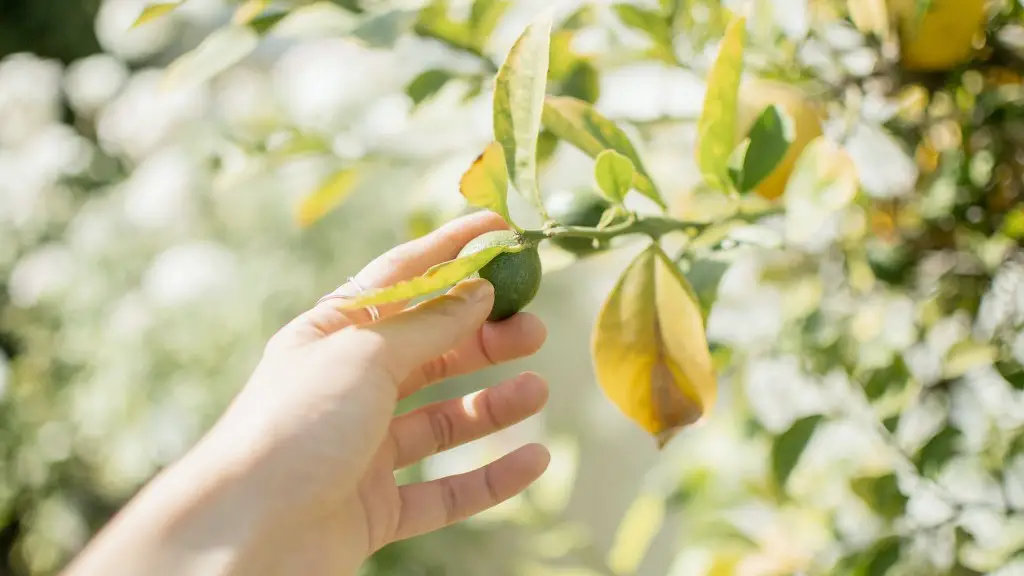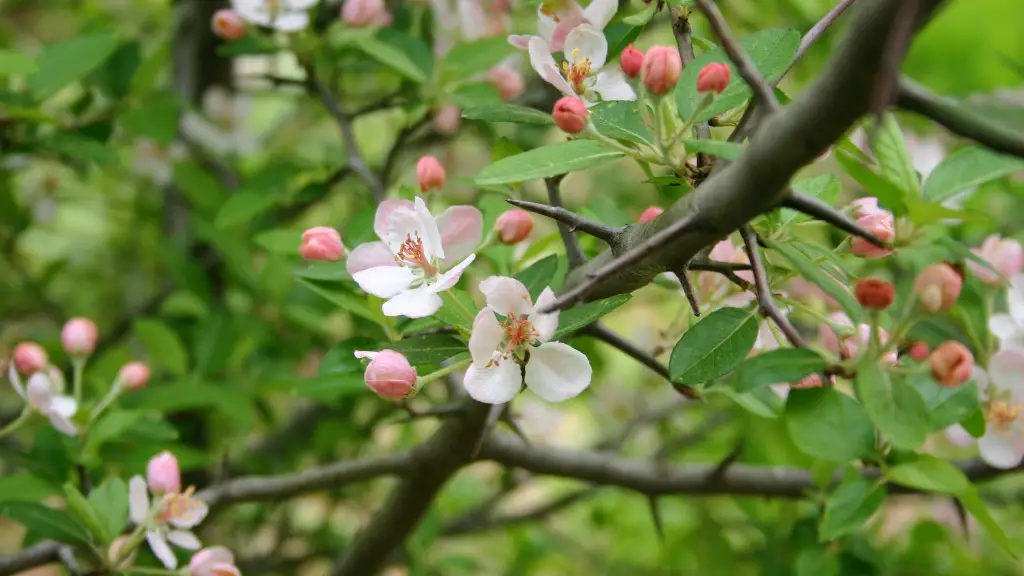The lemon tree is one of the most popularly cultivated fruit trees in the world, known for its bright yellow fruits, which can be harvested and enjoyed for their piquant flavor. Many people are keen to cultivate a lemon tree in their backyard, but many are not aware of the amount of time it takes for a lemon tree to bear fruit.
A lemon tree typically takes at least three years before it bears its first fruit. While the tree may appear to be mature in terms of growth, it is not yet able to produce fruit until the third year. It is therefore important to be patient with a lemon tree, as it can take up to four or five years until it is able to bear regular fruit harvests.
Fruit bearing seasons vary depending on the species and cultivar of lemon tree. The season typically begins in the winter with some cultivars and can last till late summer. The cycle of harvesting and juvenile growth indicates that a single lemon tree can bear fruit for between 7 and 10 years.
Fruit production is optimal when growing conditions are at their best, meaning that adequate water, fertilizer and light levels are needed. For best results, ensure the planting location has a well-draining soil, as well as includes enough space for root growth.
One of the most important aspects of ensuring your lemon tree bears fruit is pruning. Pruning should be done regularly and is necessary for removing dead branches and improving air circulation. Pruning also helps with fruit thinning and shaping, so that the tree is less likely to be topheavy, resulting in a better production of lemons.
Finally, citrus trees are extremely sensitive to cold temperatures. If temperatures drop too low or remain below freezing for an extended duration, the tree can suffer permanent damage, resulting in a decrease or complete halt of fruit production.
Soil pH and Nutrients
The soil in which a lemon tree is grown is critical for the production of lemons. Ideally, soil pH should be around 6.0, though a range between 5.5 and 6.5 is also acceptable. As well as this, fertile soils should also contain high levels of nitrogen, phosphorous, magnesium, and potassium available for absorption.
The presence of other elements in the soil can also be beneficial for lemon trees. Potassium and magnesium helps produce vigorous growth and enhances fruit quality, while adequate levels of calcium can enrich the production of juicy, sweet lemons. Boron is also important, as it helps prevent the development of water-stressing ‘blossom end rot’ and minimizes other fruit disorders.
Ideally soil should be fertilized with a balanced, slow-release fertilizer; this will provide all the necessary elements in the right quantity to promote healthy growth. If loss of nutrients is found, as they are leached out of the soil, consider supplementing with liquids or granular fertilizer often to retain sufficient quantities in the root system.
When irrigating lemon trees, ensure that a regular schedule is maintained. Drought conditions can lead to the Lemon Tree’s delayed growth, as well as to the decrease in crops and poor quality of fruits. If rainfall is too low or insufficient, supplement with manual irrigation, ensuring enough quantity and depth of water for the roots.
Lastly, regular monitoring of soil nutrients and pH is vital because both low and high levels can effect growth and fruit production. By taking these few simple steps, your lemon tree can be healthy and productive.
Conditions and Pest Control
Lemon trees are sensitive to different temperatures, so the right care should be taken when growing them. Cold, sudden winds can slow down or stop the production of fruits and can even damage the tree. Make sure to plant the Lemon Tree in a location with enough shelter from wind and frost.
If temperatures are lower than expected, the tree needs extra protection. Cover the tree with a blanket or wrap the branches and trunk with plastic film, as this can provide additional warmth, while also reducing damage from hail, hail, and rain.
Pest control is another important aspect of ensuring a successful production of lemons. Frequent inspections should be done to spot and hunt for critters such as mealybugs, scale insects and mites. Targeted use of insecticides should be applied in order to reduce pest threat.
Apart from this, organic methods of pest control, such as the introduction of beneficial insects, improving air circulation, and removing infected sections of the tree, can also be used.
Fungal diseases are also a potential threat to Lemon Trees. If noticed, infected parts should be trimmed and disposed of. As a preventive measure, mulching should be done and as a way to reduce moisture and disease incidence.
Finally, over-watering, low temperatures and lack of drainage are potential causes of root-rot, which can lead to the death of the tree. It is therefore important to make sure that the roots remain properly aerated and never let waterlogging to occur.
Harvesting and Post-Harvest
Once a lemon tree is mature and well taken care of, it is time to start harvesting. The exact harvesting time will depend on the variety of lemon tree and its maturity, but usually lemons can remain on the tree for 3 to 6 months.
The best way to know when it is the right time to harvest is to sample the fruits over a period of time. As they mature, they should be brightly colored and released easily from the branch when gently pulled. If the fruits are sour, it is best to wait a bit longer; if they are overripe and soft, it is best to harvest soon.
Once ready for harvest, the fruits should be handled with care. Always pick fruits individually, ensuring to cut the fruit from the branch and avoid tugging, which may damage the branch. It is also recommended to avoid pulling out the stems, so that the fruits remain intact.
Once collected, a careful selection process should be done, discarding damaged lemons. Proper storage will also be necessary, which can be done in cardboard boxes, lined with thick paper to avoid any damage due to impacts.
All in all, a healthy lemon tree can bear fruit for several years, with correct care and maintenance. Regular pruning and pest management, enabling draining and providing adequate irrigation, combined with suitable temperatures, result in a healthy and productive lemon tree.
Companion Planting
In the process of ensuring a successful lemon tree, companion planting can play an important role. When planted in the right location in your garden, different plants can create a suitable environment for the Lemon Tree to flourish.
Certain varieties of basil, rosemary, chives, garlic, and cilantro, for example, help repel pests and also entice pollinators. Tomatoes, peppers and corn can also be planted near a lemon tree, as they all require similar soil types, pH and fertilizer types.
Companion planting can also assist in proper weed management. Garlic, for example, can keep the area clean, preventing weeds from appearing due to its strong scent. Additionally, vetch and clover grown near a tree can provide shade, prevent moisture loss and provide shelter from cold winds.
While the larger, longer-lived trees will require more management and maintenance, they can also block direct sunlight and create a beautiful effect on the garden, particularly when winter shades are needed.
Pollination
In order to promote successful fruit production, cross-pollination is essential. This can be carried out with the assistance of bees, butterflies, and even hummingbirds, not to mention other insects. The transfer of pollen between different trees increases the chances of successful fertilization and thus, higher fruit production.
If the environment is not suitable for pollinators, consider the use of a bee brush or a bee stick. Manual pollination ensures that the Lemon Tree can benefit from regular and effective transfer of pollen between male and female flowers.
Other methods of manual pollination may involve holding flowers near a fan or other wind sources, for easy transfer of pollen. As manual pollination is quite labor intensive and time-consuming, it is best to attract natural pollinators if possible.
For this, certain flowers, such as dandelion, daisy, crocus and snapdragon, can be planted in the vicinity of the lemon tree. Trees such as citrus, elderberry and poppies, can also increase the amount of visits from natural pollinators.
Conclusion
In conclusion, a healthy and productive lemon tree is possible with dedication and effort. It can take at least three years for a lemon to produce its first fruit, and harvesting can occur for up to 10 years. Soil pH, nutrients, water and temperature levels, as well as companion planting and pollination, all play a fundamental role in the life of a lemon tree. When these parameters are taken into consideration, it is possible to experience the pleasure of harvesting, consuming and enjoying homegrown lemons.



